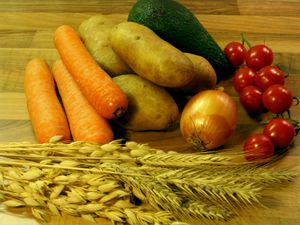Food
The amount of Food for human beings that can be brought from Earth to Mars is limited, and the logistics of a continued food transport for the long term is expensive. Especially an autonomous colony needs it's own food production. Reasons for this are cost reduction and the achievement of independence from Earth. Last but not least, the own food can be of higher quality and fresh, including a natural mix of vitamins and minerals.
Contents
Food that can be brought from Earth
- Several varieties of dehydrated food.
- Natural food that contains large amounts of fat and carbohydrates, such as nuts.
- Concentrated fruit juice.
- Light weight, high energy foods with a long shelf-life.
Local Production Methods
- Vegetable can be grown in greenhouses or on green walls in order to close the carbon cycle.
- Proteins, fat and carbohydrates can be produced by a biotechnological factory
- In-vitro meat
- Animals, such as chicken or fish, may be raised in sections of greenhouses.
- It must be taken into account that the production of 1 kg meat requires 7 to 16 kg of vegetable matter.[1]
- In addition, it takes 2000 to 3000 litres of water to produce 1 kg of meat, it only takes 100 litres of water to grow 1 kg of grain. Water will be a very valuable commodity on Mars, so the first generation of settlers may well be vegetarian by necessity.
- Growing insects and their larvea (e.g. flour worms or fly maggots) can provide valuable proteins and might consume just waste biomass.
- Algae
- Some food (possibly genetically modified) may be grown in the Martian atmosphere. Results from the Phoenix lander indicate that some vegetables may be grown in caves safe from radiation.
Nutrition and Energy Calculations
Assuming we have no genetically modified plants for the Martian colony we can only try to provide optimized conditions in the greenhouse for maximization of harvest. The following calculation is, therefore, based upon terrestrial agricultural figures.
Potatoes
Under best conditions on Earth it is possible to grow 3 kg potatoes per m2 per year. 3 kg potatoes contain 8820 kJ energy, which roughly serves the energy requirements for one person for one day. So, a person needs about 365 m2 cropland at a minimum to survive.
Wheat
The average harvest of wheat is 0.28 kg per m2 per year. Under best conditions it is possible to grow 0.7 kg per m2 per year. 0.7 kg wheat contain 9198 kJ energy, which roughly serves the energy requirements for one person for one day. So, a person needs about 365 m2 cropland at a minimum to survive.
Facts and figures
- Sweden: 26260 kg potatoes per hectare [2]
- Sweden: about 6000 kg wheats per hectare [3]
- "Plain boiled potatoes are naturally low in fat and provide 72 kcal/100g (306 KJ/100g)" [4]
- "Wheat flour provides 310 - 340 kcal/100g (1320 - 1450 KJ/100g)"[5]
Crop yields[6]
| Crops | Yield (tonnes per hectare) |
|---|---|
| Winter Wheat | 5.9 |
| Spring Wheat | 3.1 |
| Fall Rye | 2.6 |
| Oats | 3.2 |
| Barley | 3.3 |
| Mixed Grain | 2.8 |
| Grain Corn | 10.5 |
| Canola | 2.6 |
| Soybeans | 3.1 |
| Dry White Beans | 2.3 |
| Coloured Beans | 2.3 |
| Fodder Corn | 50.2 |
| Hay | 6.3 |
Meat production
Feed conversion ratio is a measure of efficiency. It is the ratio between the mass of feed and the mass of product output. For dairy cows, for example, the output is milk, whereas in animals raised for meat (such as beef cows, pigs, chickens, and fish) the output is the flesh, that is, the body mass gained by the animal, represented either in the final mass of the animal or the mass of the dressed output.
| Livestock | FCR | |
|---|---|---|
| Beef | 4.5–7.5 | calculated on live weight gain |
| Dairy | ||
| Pigs | 3.8-4.5 | About 1 for piglets, grows higher and higher with time |
| Sheep | 4-6, 40 | 4-6 on grain, 40 on straw |
| Poultry | 1.6-2 | A hen can lay up to 330 eggs per year. Maturation is about 40 days |
| Criquets | 0,9-1.0 | |
| Fish | 1-1.5 | Higher for fish to fish conversion |
| Rabbits | 2.5-3 |
Open issues
- What sorts of food are required to keep the settlers healthy? We need a nutrition plan on a scientific base.
- What esculent animal/insect/worm etc. needs the smallest amount of vegetable? The best mass ratio is sought-after. A list would be highly welcome.
- What is known about needed vitamins and minerals?
- Is it possible to make artificial food with an artificial mixture of vitamins and minerals, allowing humans to keep well and fit?
See also
References
- ↑ Kate Thompson: What you can do resource - facts and figures about resource consumption for food production.
- ↑ Press release from Statistics Sweden and Swedish Board of Agriculture
- ↑ Report from State of Sweden
- ↑ British Nutrition Foundation - Potatoes
- ↑ British Nutrition Foundation - Flour
- ↑ https://ourworldindata.org/yields-and-land-use-in-agriculture







